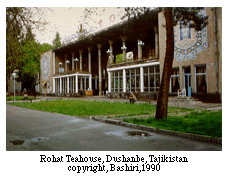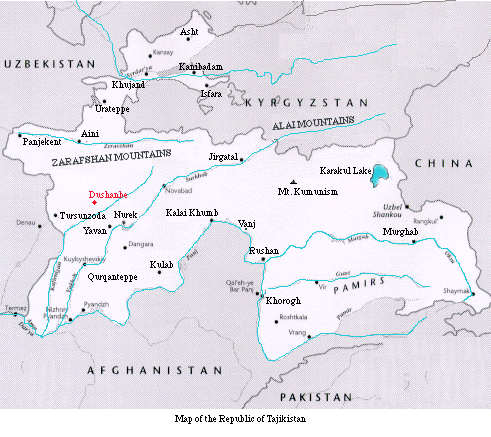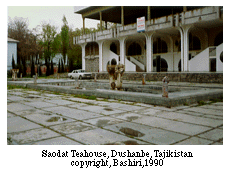
by
Iraj Bashiri
copyright, Bashiri 2000
As we strolled down Rudaki Avenue (formerly Lenin Street), Vose talked about the significance of the Choikhona in Tajik life. "Choikhona," he said, "is a public place for rest. It is comprised of two sections, a place for fixing tea (usually referred to as the samovarkhona) and a place for serving tea."
"Is this a new phenomenon or does it have a history?" I asked.
"Well, a bit of both," he said. "In medieval times the choikhona was an inseparable part of the caravansaries in the desert. These large structures served as a refuge for the caravans at night and protected travelers from the bandits. Later on they were attached to the bazaars in towns and villages, as well as built at crossroads and in other places with ample traffic."
"This sounds very much like the history of the qahvakhonas (teahouses) in the Middle and Near
East," I said.
"Correct," Vose said. "In Central Asia the teahouse became the focus of activity in population centers after the introduction of tea which itself was originally used as a kind of drug."
"Did tea come to Central Asia by way of your neighbor to the east, China?" I asked.
"Strangely enough, no," he said. "It came to Central Asia via our neighbor and big brother to the north, Russia. Apparently, as early as the middle of the 17th century. 1 V. Starkov, the Russian ambassador to Mughulistan, introduced the tea plant and its use into Russia; it did not reach Central Asia proper until the end of the 19th century."
"Where were the first tea plantations in Central Asia located?" I asked.
"Apparently in Sukhumi, 2 " he said. "With very good results..."
"But that is not in Central Asia."
"Depends," he said. "Maybe not the American Central Asia."
"In any event..." I conceded.
"In any event," he continued. "In the 1860's, Azurgeti became a major center for the production of tea followed by Azerbaijan. 3 From there tea mania spread to the Caucasus and the shores of the Black Sea on the one hand and to what we know now as Soviet Central Asia on the other."
We were now reaching the end of what is normally regarded as a full stroll along Rudaki Avenue, Dushanbe's main street.
"May I ask you a personal question?" I asked.
"It depends how personal it is," he replied with a straight face.
"Oh, just about your educational background. You know as much about tea as I know about languages or history."
"I took a course in botany and wrote a paper on teahouses."
"And that's why you were assigned to familiarize me with teahouses?"
"Maybe so."
We were now at the end of our short stroll. Sa'odat teahouse to our right announced its existence in both Cyrillic and Farsi scripts.
Surveying the empty pool, Vose lamented, "unfortunately, at the present, there is a water shortage in this part of town. Usually the pool (or hauz) is full of water, a major element in choosing the construction site for the teahouse."
Not knowing quite what to say, I stopped at the edge of the pool and surveyed the statues that were placed in and around it.
"When there is water and the pool is full, water gushes out of the mouths of the griffin-like faces surrounding the middle statue. It is a wonderful sight to watch while drinking tea."
I agreed, trying to visualize the ambiance Vose was trying to convey.
Although it had a door and windows, the teahouse shared the open air with the outside. Large arches held the ceiling as well as separated parts of the teahouse from each other, creating semi-private chambers. Large blue and white topchan (benches) were placed a comfortable distance from each other for serving groups of guests. In fact, guests were sitting or lying on some of them. Some were drinking tea. Others were playing chess or just engaged in conversations.
Seeing us, the proprietor approached and, with his hand on his chest as a sign of respect, asked if we were part of a larger party.
"No," said Vose. "Just the two of us."
"Khush omadid (welcome)," he said, never taking his open hand off his chest or standing upright.

We were then ushered in and directed to a topchan. He motioned for us to sit. The topchan was covered with purple silk with cushions to the side for resting. "Ustod here is from America. I am showing him our teahouses," Vose started the conversation.
"Khush omadid," the proprietor said again, extending his free hand to shake mine. "Guests are friends of God," he added. "Ustod is a guest at our teahouse. You need not order. I know what to bring."
He then left us. Vose and I made ourselves comfortable on the topchan and resumed our talk about tea.
"Depending on preparation methods," Vose explained, "there are at least three distinct types of tea in Central Asia. The first is 'Black Tea.' It is produced by subjecting the tea leaves to a heat medium of about 40 to 50 degrees centigrade (104-122 degrees F.) until the leaves wilt. The wilted leaves are then rolled and fermented to get rid of their bitter taste. The result is a black and fragrant leaf which is then dried and sorted out according to various commercial purposes.
"I don't think he'll bring us that kind of tea because it looks so much like American tea, as far as color is concerned, of course.
"Then there is 'Blue Tea,' which also undergoes the same process as 'Black Tea,' except before wilting, the leaves are subjected to intense steam (as much as 100 degrees centigrade, or 212 degrees F.). After the tea leaves are unrolled, the resulting color is green, rather than black." 4
"Then do you think that is the tea that he is going to bring us?" I asked.
"I don't think so. As you are an honored guest, even though 'blue tea' is the most expensive, I think he will serve you 'gulchoi (literally, "flower-tea")'. The tea leaves for this variety are severed from the mother plant before they are fully opened. For this reason, the tea retains its original pleasant taste and fragrance. I think you will attest to that once you take your first sip."
I did not get to have my first taste of gulchoi that day. Our host brought us blue tea with an apology. "With the situation as it is," referring to the recent attacks on the shops, 5 we are not getting our regular consignment of tea. Blue tea is the best we could do. I hope Ustod understands that."
"Come to think of it," Vose said to the proprietor, "you are rather close to the action here. Did any harm come to your establishment as a result of the recent riots?"
"No, sir. No harm worth mentioning. As they pushed their way towards the center, a few stray bullets hit the front, but that's fortunately the extent of it."
"Alhamdullihah (God be praised)," Vose exclaimed and added, "I showed Ustod the places that were burnt in the riots and the damage to our beautiful town."
"I don't know who is behind this but, whoever it is," the proprietor said almost teary eyed, "he is not a Tajik. No one with Tajik blood coursing in his veins would do what they have done to Tajik property. They are setting up brother against brother and, unfortunately, we all know what that leads to. But, here and now, I promise Ustod that, God willing, if we all survive this, I will serve him the best gulchai produced in Tajikistan."
I didn't want to get involved in their complex discussion neither did I know quite what my proper response should be, other than thanking him. Vose came to my rescue. "You are most kind," he said. "Ustod understands perfectly well. He is not a Tajik but knows our culture better than some of us. God-willing things will get better and Ustod will visit us again in the near future. Then we will visit you and drink gulchoi together."
Following tradition, the whole social ritual (taarof) was repeated by the proprietor saying, "Nasib boshad (let's hope so)." He then placed bread, yogurt, parvarda (a kind of sweetmeat), and several kinds of nuts on the dastarkhan, a hand-made tablecloth.
As if obliged to walk me through the whole history of tea production in Central Asia, Vose continued. "Tea was introduced first into Bukhara from where it found its way to Samarqand, then to Tashkent, Khujand, Urateppe, Konibodom, Panjakent, and Khuqand. Towards the end of the 19th century, it reached the Ferghana Valley proper and as far as the Zarafshan region. It took still some more time before it reached the people of the Kuhistan."

Unlike in the Middle East where tea is prepared by the proprietor and brought to the customer, in Tajikistan the customer makes his own tea. 6 The proprietor provides the teapot, dry tea, and some extremely hot water.

Vose took the teapot, rinsed it out with some of the boiling water, put a handful of tea leaves in it, and filled it up with boiling water. While he talked, the tea steeped in the choinik (a teapot made of china with a handle on one side and a spout on the opposite side) which was covered with a cover in the shape of a taj (crown) for five or six minutes. When the tea was ready, he picked up a piyola (a cup or goblet with floral designs used for drinking tea), poured some tea in it to warm it up and then poured the tea back into the teapot. He did that ritually three times. Then he filled the piyola about half full and placed it in front of me.
"Let me tell you a rule for serving tea." He smiled as he looked at the piyola. "A full piyola placed before a guest indicates that the host wishes the guest to drink it quickly and leave. A half-filled piyola anticipates refills for many times. These are rules that are not in any books but are known by all Tajiks."
"That's a wonderful rule, especially if you are in a hurry, like we always are, to nicely signal your intention."
"Ours is an ancient and complex culture," he said. "We cannot afford antagonizing each other. So we approach our problems in more subtle ways."
"What other choikhona rules like this are there?"
"No. Please don't misunderstand," he said somewhat agitated. "These are not choikhona rules. They are also khona (at-home) rules. When someone comes to your house, you try to be as kind as you can be. So you may keep filling the person's cup even when the person has had enough. If ever you are in this situation, all you have to do is turn your empty cup upside down and place it in front of you. That signals to your host that you wish to continue to talk but have had your fill of tea."
"Just like that?" I asked.
"Just like that," he repeated.
"Earlier you talked about the three types of tea," I said and continued, "Do various regions
drink various types of tea or is the choice socially driven?"
"A bit of both," he said. "As Soviets, we do not have social classes; however, some Tajiks continue to cling to tradition. The division, however, as far as I know, is primarily by region. In Tajikistan, except for the Pamir region, as well as in Kyrgyzstan, Turkmenistan, Khwarazm, and the Zarafshan and Ferghana Valleys, people drink 'Blue (kabud) Tea.' In Parts of Uzbekistan, however, especially in Tashkent, and in Kazakhstan 'Black tea,' also referred to as "choiye fomili" is preferred."
As I left, I left a tip for the proprietor. Vose was adamant that I should not do that as it was absolutely against the Tajik custom. I convinced him that I realized that it was against the Tajik code, but that it also was against my American custom not to do so. He agreed at the end, although protesting that the amount was many times more than we would have paid if it were not a tip. I explained to him that in American terms that was not even a fraction of what is usually given.
Before closing our discussion of the teahouse and thanking Vose for his wonderful contribution to my understanding of the central role of the choikhona in his culture, I asked, "If I were to write something about teahouses in Central Asia, is there anything else that I should know--I mean major developments like when the teahouses left the caravansaries in the desert and entered urban centers?"
"Yes, he said firmly. "We did not talk about the Red Choikhonas."
"What do you mean? Is this something like black and blue tea?" I joked.
He smiled again his usual smile, "No, Ustod. "During the early days of Soviet rule in Central Asia, a number of Red Teahouses came into existence. They were established as "agitation" or 'propaganda' centers with special organizational and administrative tasks. Meetings of the soviets, Party committee meetings, and secret meetings to iron out strategy were usually scheduled in Red Teahouses. Gradually, the sphere of operation of red teahouses widened to include almost all centers of public gathering in kolkhoses (collective farms), sovkhozes (state farms), industrial centers, construction centers, and transportation depots. To better serve their clientele, the teahouses were given permission to provide newspapers, journals, as well as facilities for playing chess and backgammon. Workers could retire to any of these teahouses and amuse themselves by listening to the radio.
"Later on, teahouses became centers of gathering for war veterans, parliamentarians, scientists, artists, and poets. During the 1970s and 1980s, in major cities like Dushanbe and Khujand, as well as in the centers of regions and often rayons (districts), a series of splendid teahouses were constructed. Decorated in national style, these teahouses are distinguished by name in each city. For instance, our Dushanbe is known for the 'Sa'odat,' (which means "Felicity") the teahouse we are in, 'Rohat,' 7 (which means "Comfort") and Faroghat,'8 (which means "Leisure") which are on our way to the hotel. I think I showed them to you as we walked by them. They are all on the same side of the street as 'Sa'odat.'
"Yes, you showed them to me," I confirmed.
"When you visit Khujand, which I understand is on your itinerary, make sure to see the well-known 'Panjshanbe' ("Thursday") teahouse. In Isfara you have 'Orom' ( "Abode of Peace"), in Urateppe 'Guli Surkh' ("Red Flower"), and in Qurqanteppe 'Dilkusho' ("Happy Heart")."
On our way out, as if he suddenly remembered, he headed for the side of the teahouse and the stairs. "One more thing, Ustod," he said. "Probably the most important."
I caught up to him.
"I forgot to show you the main part, the art work. This section is closed for renovation but, I don't think the proprietor would mind if you took a look."
Upstairs there was a gallery with walls and ceiling decorated with brightly painted floral and geometric designs, the same rhythmic patterns that appear on tilework in mosques. The sumptuously ornate ceiling was held up by beautifully carved pillars, each carrying a slightly different design but all looking majestic and regal. I no longer felt I was in a teahouse but more like viewing the art work in Esfahan's palace of Ali Qapu or Chihil Sutun..
"So, what do you think?"
Vose's first question was hard to answer. "It is gorgeous, simply astounding. How many hours are spent on this floor? How many artists have been engaged in putting this wonderful piece of work together..."
"Well, building teahouses is a slow process."
"They are not built in one day, I am sure," I agreed.
"Over time many artists have contributed to its development," Vose continued, "as you would contribute to the building of a space station."
Engaged in the discussion of the choikhona as a symbol of Tajik culture, we had left the teahouse, walked down Rudaki Avenue and were now approaching Hotel Tajikistan. All that was left was to make arrangements to see each other the next day to become more familiar with each others' cultures. I thanked Vose for his time and for sharing his knowledge with me, said goodbye and departed.